Pioneering geochronologist whose work spanned several continents.
 Norman Snelling, who died peacefully on 12 January 2020, was a pioneer in the application of potassium-argon (K-Ar) geochronology.
Norman Snelling, who died peacefully on 12 January 2020, was a pioneer in the application of potassium-argon (K-Ar) geochronology.
He graduated from the University of Manchester in 1951 and won a scholarship to The Australian National University at Canberra. His PhD, published in QJGS in 1960, was on the petrology and mineralogy of the Palaeozoic granites of the Murrumbidgee batholith – in his own words “wonderful country, virtually uninhabited, just bush, forest and mountains ranges (plus the usual kangaroos and snakes)”.
Isotope analysis
In Canberra John Richards introduced Norman to the isotope analysis of gases. Together they built an early version of the equipment necessary to date rocks from the radioactive decay of natural potassium to an isotope of argon. This defined the course of Norman’s subsequent career, starting with postdoctoral work on K-Ar dating at the Geological Survey of Canada.
His role in the emerging science of geochronology was recognised in 1959 when he was recruited to lead a small rock-dating unit for the UK Directorate of Overseas Geological Surveys (OGS). This was based at Oxford University, where Lawrence Wager had assembled a team of experts to establish what became an internationally recognised geochronology laboratory.
The symbiotic relationship lasted until 1969 when the survey unit was taken in-house in London, briefly in an old Post Office building in Young Street, Kensington and then in a converted office block in Gray’s Inn Road, Holborn. Under Norman’s direction for the next 19 years it grew in size and the scope of methods used.
Travel and publications
In 1965 OGS was absorbed into the Institute of Geological Sciences, by which time Norman had already conducted projects worldwide, working with survey and university geologists and students. He travelled widely and sent members of his group to continue detailed studies, and indeed to develop their own careers. He was widely appreciated for his role in technology transfer, giving advice and help in setting up autonomous K-Ar dating equipment.
His joint publications provided primary data for the geological evolution of countries as diverse as Malaysia, Morocco, Sierra Leone, Botswana, British Guiana and Chile. In 1966 and 1984 he co-authored books comprehensively reviewing the geochronology of the African continent. He edited and contributed to the much-cited Geological Society Memoir No. 10 (1985) “The Chronology of the Geological Record”.
Retirement
In 1988 Norman retired from what had become the British Geological Survey. He was then instrumental in launching the Journal of South American Earth Sciences where he was Co-Chief Editor for four years, returning as Chief Editor for 1996 to rescue it at a critical stage of management difficulties. He had meantime undertaken a role assisting with a new geochronology laboratory at Universidad Complutense, Madrid, where in 1991 he was given a full professorship that lasted until his final retirement in 1996.
Norman is remembered as kind and generous by his colleagues. Despite his global travelling he was a devoted family man and is greatly missed by his second wife, Carmen, two children by his first wife Anne, three stepchildren, grandchildren and greatgrandchildren.
By Bob Pankhurst